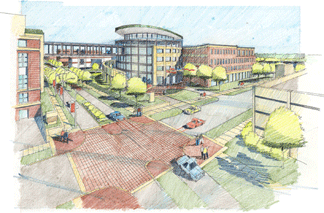 |
A conceptual drawing of UNMC’s proposed Center for Health Science Education Building. |
To bring that vision into focus, UNMC is proposing to construct the Center for Health Science Education Building. No state tax dollars will be used for construction of the building. The University of Nebraska Board of Regents will consider a program statement for the new building at its meeting on Saturday, Dec. 13.
“UNMC is a national leader in many areas, and it’s important that we remain a leader in educational training to best serve the needs of Nebraskans,” said UNMC Chancellor Harold M. Maurer, M.D. “This project is essential if we are to be a national educational leader in the 21st century. Nebraskans deserve top-notch care from their care providers, and this project will go miles toward assuring them that UNMC will be on the cutting edge in medical education in the years to come.”
Rubens Pamies, M.D., vice chancellor for academic affairs at UNMC, said the current buildings at UNMC are not conducive to the educational experience that will be necessary to train physicians in the next century. Dr. Pamies said the new building would allow students to learn in settings that have been deemed most effective for health-care training. Classrooms would provide ample opportunity for professors and small groups of students to interact. Gone are the days, Dr. Pamies said, of “I teach; you learn.”
|
Most of the IT employees would be relocated to about 35,000 square feet of presently vacant space in the 4230 Building. The balance of the IT employees, the Physicians Assistant Program faculty and the Chemical & Radiation Safety organization would be relocated into vacated space in Poynter and Bennett Halls. That space is currently occupied by researchers whose labs will move into the Durham Research Center. Specific relocation sites will be determined during the design phase of the project, which could be completed in summer 2004, at the earliest. |
“The new building would allow our educational vision to become reality,” Dr. Pamies said. “We need to look at the teaching environment as an educational laboratory. Small-group discussion and interaction has been shown to provide the best results, in terms of learning.”
The 131,296-square-foot Center for Health Science Education would be located at the northeastern corner of 42nd Street and Emile Streets. It would be home to the UNMC College of Medicine, Dr. Pamies said.
“We are tremendously excited for the opportunity to take our students’ educational experiences to an even higher level,” said John Gollan, M.D., Ph.D., who will assume his role as dean of the UNMC College of Medicine on Monday, Dec. 15. “This university’s vision for excellence extends to education, and this building would allow us to educate and train the next generations of physicians, so that they can diagnose and treat Nebraskans at an exceptionally high level.”
Dr. Gollan credited the vision of Dr. Maurer and other campus leaders.
In all, building the Center for Health Science Education would cost $52.7 million. This amount includes: construction of the new center; the demolition of properties currently on the site; the relocation of departments and units currently there; construction of a greenway along Emile Street from 42nd Street to 40th Street; the remodeling of 12,500 square feet of space in Wittson Hall, the current home of the College of Medicine; and the construction of a sky bridge across 42nd Street, from the new building to Wittson and Bennett Halls.
Don Leuenberger, UNMC vice chancellor for business and finance, said the Center for Health Science Education would replace obsolete and insufficient facilities with state-of-the-art classrooms and class laboratories, including a clinical skills learning and assessment facility and small-group instruction rooms.
“In essence, the new building would create a ‘heart’ for UNMC education activities and serve as a front door for the campus,” Leuenberger said. “It will allow our students and faculty to interact in a building with a multitude of functions.”
Leuenberger said many other Midwestern universities, such as the University of Iowa and the University of Wisconsin, have taken similar approaches.
The UNMC College of Medicine is the major training environment for physicians who practice in Nebraska, with about 120 physicians graduating from UNMC each year. In addition, 13 UNMC clinical departments provide postgraduate graining for about 400 residents.
In addition to ultimately providing better care to patients, medical students would also benefit from the new building’s 12 rooms designed to simulate clinical settings. Beginning in 2005, graduating medical students will need to take a Clinical Skills Assessment Exam (CSAE), in addition to the traditional written exam, to become board-certified.
“Currently, our students learn clinical skills in four rooms that are small and outdated,” Dr. Pamies said. “These new spaces will provide a much more realistic view of what the students will encounter during their board examinations and ultimately, when they enter private practice.”
Dr. Pamies said the possibility of a new learning environment excites him.
“Great clinical care is taking place at UNMC clinics and at our partner, The Nebraska Medical Center. Our outreach won a national award from the Association of American Medical Colleges. Our research growth is outstanding, and the Durham Research Center will further fuel that. Now, we need to become even better in the educational arena. This new building will allow us to do that.”